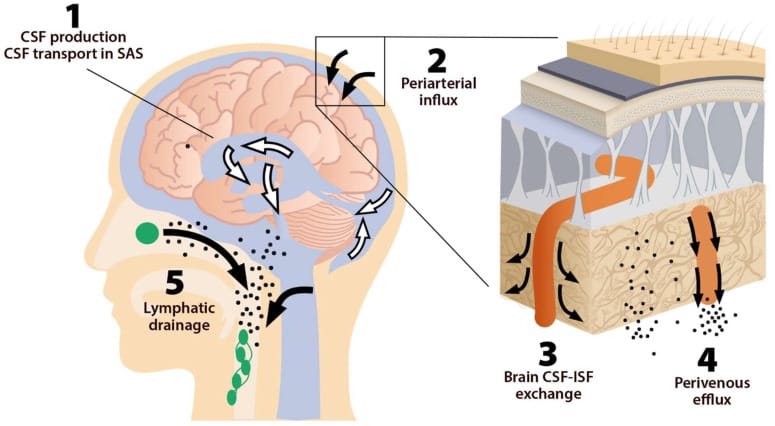What is the Glymphatic System?
The glymphatic system is a newly discovered macroscopic waste removal system in the brain, discovered in 2012, which works in a similar fashion to the lymphatic system which removes waste from the body. This system enhances the effective disposal of soluble proteins and metabolites from the central nervous system.
Due to our increasingly indoor activity, especially during the winter, we are not exposed to the natural light of the sun nearly as much, which includes not only visible light but Infrared and ultraviolet as well. This can have detrimental effects on our circadian rhythm/sleep cycle as well as immune function, including the brain's toxic waste removal system. Infrared light exposure, specifically before bed at the end of the day can increase melatonin production aiding in falling asleep and removal of soluble waste proteins such as tau, alpha-synuclein and beta-amyloid. The efficient removal of these wastes is crucial for maintaining brain health and preventing neurological disorders.
What are these waste proteins?
- Tau: Tau is a protein vital for the structural stability and nutrient transport within brain cells, as it stabilizes microtubules in neurons. However, in neurodegenerative diseases like Alzheimer's, tau can become dysfunctional and form clumps known as neurofibrillary tangles. These tangles disrupt cell function and contribute to neuron degeneration, making tau a key focus in research on Alzheimer's and similar conditions.
- Alpha-synuclein: Alpha-synuclein is a brain protein involved in neurotransmitter regulation and synaptic function. Its exact role is not entirely clear, but it becomes crucially important in neurodegenerative diseases like Parkinson's. In these conditions, alpha-synuclein misfolds and forms aggregates, resulting in Lewy bodies within neurons. These aggregates are characteristic of Parkinson's and some dementias, and their presence is linked to neuronal degeneration. Thus, alpha-synuclein is a key target in the study and potential treatment of these disorders.
- Beta-amyloid: Beta-amyloid is a protein fragment from the amyloid precursor protein, associated with neuron growth and repair. It forms sticky plaques that disrupt cell communication in the brain, a hallmark of Alzheimer's disease, leading to cell damage and disease progression. Understanding beta-amyloid is essential in Alzheimer's research and treatment development.

Imagine your brain is like a bustling city, and like any city, it needs a good cleanup crew to keep things running smoothly. That's where Photobiomodulation (PBM) therapy swoops in like a superhero! It's a fancy way of shining a special light on your noggin to help the brain's janitors, the Cerebrospinal Fluid (CSF) and Interstitial Fluid (ISF), sweep away the cobwebs and gunk that can mess up your mental mojo.
Science has given us a wink and a nudge, showing that if you let this light therapy wave its magic wand over your head for 20 minutes a day, at least four times a week, for about half a year, your brain could be on its way to becoming a lean, mean, thinking machine. CSF and ISF aren't just any fluids; they're the body's very own VIPs, keeping everything in check from your toe-tapping rhythms to your puzzle-solving prowess. If they start acting funky, it could be a sign that something's up in your bodily borough, making PBM not just a brain booster but also a detective's tool for sniffing out health hiccups. So why not let the light in and give your gray matter the glow-up it deserves?
Benefits of Infrared PBM
Interestingly, Mitochondria, often referred to as the powerhouse of the cell, have a fascinating sensitivity to red and near-infrared light. These specific wavelengths, nestled comfortably in the visible red and near-infrared spectrum, are eagerly absorbed by mitochondria. This absorption plays a crucial role at the cellular level. The energy harnessed from these photons aids mitochondria in their vital task of generating ATP, the energy currency of the cell. This intriguing interaction between light and cellular energy underscores the complexity and adaptability of our cellular structures.
In conclusion, various benefits such as improved memory, increased focus and attention, reduced anxiety, increased resilience to stress and improved sleep quality can all be benefits found from using an IR helmet setup. More information can be found at:
What is Photobiomodulation? Photobiomodulation Process. - Vielight Inc
Or in clinically licensed office such as Trinity Psychology & Wellness in Alpharetta, GA
Vielight | Trinity Psychology & Wellness | Alpharetta, GA (drbobmontes.com)






